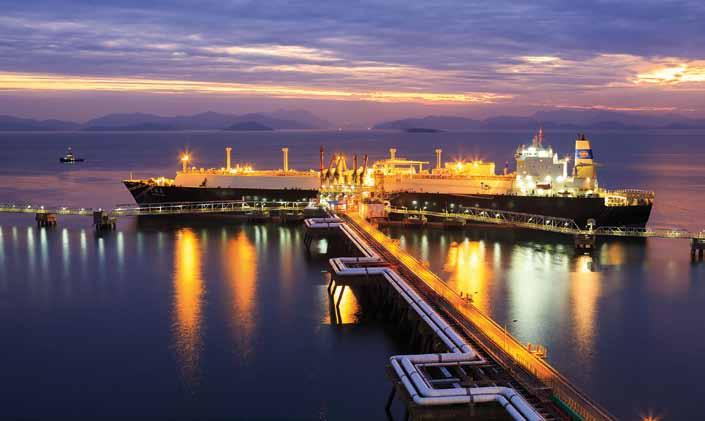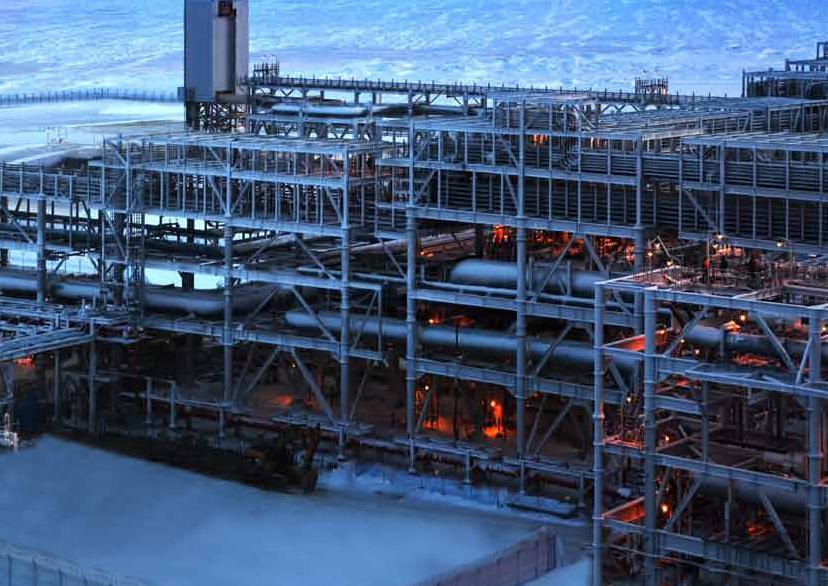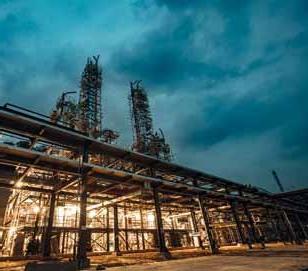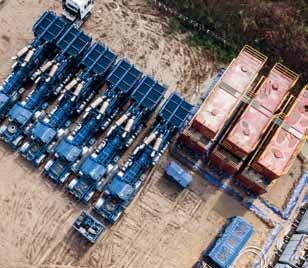
17 minute read
China’s energy strategy and natural gas development
by IGU
Chin a’s energy st rat egy and nat ural gas development
China has an energy blueprint which lays out a comprehensive plan for the world’s largest energy consuming market to 2030. By Bai Jun
In June 2014, China’s President Xi Jinping called for a “revolution” in the country’s energy sector, highlighting an urgent need for some fundamental changes in a relatively short period of time to address key challenges. As a result, the government in April 2017 published its first-ever long-term energy blueprint – Energy Production and Consumption Revolution Strategy (2016-2030). The strategy, which centres on how energy demand can be met and how energy transition will be guided, dictates China’s natural gas development and its impact on the global natural gas market.
The Energy Revolution strategy came as rampant consumption of energy, especially coal, led to rocketing discharges of pollutants and greenhouse gas emissions, endangering public health and straining environmental sustainability. Soaring demand also complicated China’s energy security.
China became a net crude oil importer in 1993 and within 24 years replaced the United States as the world’s biggest crude oil importer. China now relies on overseas supplies for over 70% of its oil consumption.
China began importing LNG in 2006 through the Guangdong Dapeng terminal (above) and piped natural gas in 2009 from Turkmenistan via the Central Asia-China Gas Pipeline.
The country began importing LNG in 2006 and pipeline natural gas in 2009, with over 40% of gas supplies now being shipped from abroad. China overtook Korea in 2017 as the world’s second largest LNG importer and eclipsed Japan in 2018 as the world’s biggest natural gas importer (including both piped gas and LNG). It will certainly dethrone Japan as the world’s top LNG buyer in a few years. The seemingly unbridled appetite for overseas oil and gas has elated global suppliers, but it also worries the Chinese government after repeated incidents of supply disruption.
In addition to the above concerns and encouraged by galloping breakthroughs in renewable energy technologies, the shale revolution in the United States, and a “new normal” Chinese economy that could be underpinned by less extensive energy demand, the Energy Revolution strategy deems building a “clean, lowcarbon, safe and efficient” energy system to be feasible, necessary and imminent.
Supply
On the supply side, the Energy Revolution strategy aims to make nonfossil energies and natural gas the biggest component of incremental energy supplies in the run-up to 2030, lifting the share of non-fossil fuels in the primary energy mix to 15% by 2020 and 20% by 2030, from 9.4% in 2010. It also eyes a 15% share for natural gas by 2030, up from a goal of

While China has substantial conventional and unconventional gas resources, both domestic production and imports need to grow to meet demand.
10% by 2020, and compared to 4% in 2010. The expansions will primarily come through continuously squeezing the market share of coal, which still accounted for 60% of energy use in 2017 despite a 12 percentage-point loss in market share over the previous decade (see Figure 1). China’s ambition in non-fossil fuels rivals that of many other countries, and its aspiration in natural gas isn’t modest either given a very low base.
Fuel market share changes (%) in China
2.5
2.0
1.5
1.0
0.5
0.0
-0.5
-1.0
-1.5
-2.0
-2.5 20012000 20032002 2004 2005 201120102009200820072006 201420132012 2015 2016 2017
Coal
Source: National Bureau of Statistics of China
Oil Natural gas Non-fossil
Figure 1.
The determination to raise non
fossil energy and natural gas use and
cut down on carbon-intensive coal is
essential for China to fulfil its commit
ments made under the Paris Climate
Change Agreement, which include
peaking domestic CO 2 emissions by around 2030 and cutting emission 2.5 intensity by 60%-65% by the same time 2.0 from 2005 levels. Actual progress in 1.5 clean energy development and emission 1.0 control has been promising as efforts to 0.5 develop non-fossil energies such as 0.0 wind, solar, hydro, biomass and nuclear -0.5 have borne admirable fruits while -1.0 natural gas development advances. It is -1.5 expected that China will exceed its non-2.0 quality in many Chinese cities has also been improving thanks to low-carbon
Growth in natural gas production
and clean energy initiatives. The Chinese capital of Beijing stands out as an example of air quality improvement thanks to its massive application of natural gas in place of directly burning coal.
However, tightness in natural gas supply, especially shortages during the heating season have raised doubts about the viability of natural gas as a reliable fuel source. China’s growth in natural gas production has outpaced both the Asia-Pacific average and the Figure 2). The country was the world’s
ducing country in the world. Still, local production has failed to keep pace fossil energy targets for both 2020 and 2030, and carbon emissions will peak -2.5 201720162015201420132012201120102009200820072006200520042003200220012000 before the pledged deadline. Air OilCoal with demand, leading to soaring gas Non-fossilNatural gas world average since at least 2000 (see 19th largest gas producer in 2000, according to statistics compiled by BP. It now ranks as the sixth largest proimports and an absorption of much of
the world’s additional LNG supplies.
20%
15%
10%
5%
0%
-5%
2000 2001 20032002 2004 20062005 2007 201020092008 2011 20132012 201620152014 2017
China
Source: BP Statistical Review of World Energy
Asia Paci c average World average
Figure 2. While the Energy Revolution strategy targets a multiplication of domestic gas production by stepping up exploration and development of rich conventional and non-conventional gas resources including shale gas, coalbed methane, tight gas and even methane hydrate, it could take years or even decades for some of these resources to be brought to the market at sizeable scale and sound economic competitiveness. This suggests that imported gas will make further inroads in the Chinese market. China’s LNG imports alone are likely to double in a few years and triple within a decade.
Demand
On the demand side, the Energy Revolution strategy emphasises curbs on coal and oil consumption and encourages utilisation of renewable energies. Coal consumption in major air pollution prevention areas can be reduced by expanding use of natural gas and other clean energy sources. Even though the latest coal-to-gas switch campaign in northern China has caused some public complaints due to higher cost, poor coordination and insufficient gas supplies and infrastructure, the government has remained steadfast in promoting natural gas and has called for more concerted efforts from all sides involved.
Given that the government has to provide subsidies for many of the coalto-gas substitution projects, further large-scale roll-outs face growing


financial difficulties and could become increasingly unsustainable. The development of gas for transportation has hit rough patches from time to time due to unstable profitability. A key solution to the dilemma is to lower the cost of natural gas from wellhead to burner tip, increasing its competitiveness against alternative fuels. Instead of worrying about the growth potential of the Chinese gas market, overseas gas suppliers need to focus on how to improve the price competitiveness of their supplies, so as to cash in on an unprecedented wave in coal replacement that could last for decades. The phase-in of carbon emission quotas or a carbon tax would lend some support to natural gas in its competition against cheap coal, but it’s unrealistic to solely count on such one-off moves to marginalise coal, which make it less affordable for consumers and potentially strand hundreds of billions of dollars of coal-related investment.
China’s energy intensity – the energy used in generating each unit of GDP – is twice or even three times as much as that of some developed countries despite significant improvements in the past decades. Energy inefficiency can include both energy waste in consumption and energy loss in conversion. Among all major fossil fuels, natural gas is the most efficient fuel when converted to either heat or power. Higher energy efficiency means lower energy demand and less emissions, it also means lower energy costs and better energy security. The Energy

As well as increasing gas consumption China is seeking to boost the use of renewable energies.
Revolution strategy regards energysaving as an important measure in securing additional energy supplies to power the economy. It proposes measures for industrial factories, buildings and the transportation and residential sectors to improve energy efficiency and reduce emissions.
Technology
Technology is seen as a driving force that can tilt the balance between supply and demand and facilitate a transition from the traditional carbonintensive energy system into a modern low-carbon one. The Energy Revolution strategy focuses on breakthroughs in low-carbon energy technologies. It also sets its sights on expanding the use of energy saving technologies, spreading applicable technologies in clean coal, oil and gas development and utilisation, and developing cutting-edge technologies for energy storage, an advanced electricity grid and the energy internet. It singles out the manufacture of gas turbines as an area ripe for technology breakthrough, thus helping trim the cost of gas consumption and making it more affordable to consumers.
Technology innovations are often derived from unrelenting efforts by creative minds in the market, but government policies and guidance also play a role, as demonstrated by shale
NATURAL GAS REDUCES AIR POLLUTION FROM ROAD AND MARINE TRANSPORT WHEN IT REPLACES DIESEL.

www.shell.com/roleofnaturalgas

Energy efficiency is an important aspect of China’s energy strategy. This gas turbine will help make the Guangzhou Zengcheng combined cooling, heat and power plant the most efficient gas-fired power plant in China.
gas technology development in the United States. Government-sponsored research and development programmes facilitate technological innovation and fiscal policies such as tax credits and rebates can help incentivise market players. While hydraulic fracturing and horizontal drilling technologies are commonly applied in US shale gas development, they need to be remodelled and reconfigured to fit Chinese geological formations and conditions. Without technological innovation and breakthroughs in exploration and development, China’s colossal shale gas and coalbed methane resources cannot be unlocked.
Institutional reforms
China’s ascendance to the world’s second biggest economic power has proved that the market works better than government command-andcontrol in terms of resources allocation. The country has decided to liberalise an energy market that was characterised by rigid price controls and a few state-owned corporate giants entrenched in their coal, power, oil or gas subsectors. The Energy Revolution strategy visualises necessary institutional reforms that include fostering an open and competitive energy market, freeing up energy prices, reducing government intervention and reshaping the energy regulatory system.
In the natural gas market, the government is following a reform policy dubbed “free up both ends, keep a grip on the middle”. It aims to bring more players into exploration and development, spin off pipeline assets from national oil companies and mandate third-party access, and foster fair competition in distribution. Market opening and regulatory improvement are necessary to entice new investors to join the natural gas promotion campaign. These and many other needed reforms, together with innovative technology, will decide whether China could repeat the shale revolution success of the United States.
Energy cooperation
The Energy Revolution strategy conceives of a multifaceted, wholevalue chain, wide-area international energy cooperation that would benefit all participants home and abroad. It centres on diversifying oil and gas supplies, expanding electricity, oil and gas interconnections under the Belt and Road Initiative, enhancing cooperation in energy technology and equipment manufacturing, and contributing more to international energy governance. An orderly global oil market remains as the focus of the international energy community for the near future, whereas integration of natural gas markets, common natural gas security and renewable energy development will gain increasing importance on the world’s energy stage as a global shift to a low-carbon economy takes shape. With renewable energy insufficient on its own to meet people’s need for safe, stable, reliable and flexible energy supplies, natural gas, the least carbon-intensive fossil fuel, becomes











the best partner for renewable energy development.
Considering a global abundance of natural gas resources and the merits of the fuel, China’s great transition to the “clean, low-carbon, safe and efficient” energy system cannot be achieved without the deep involvement of the international gas community. The country needs more and more gas imports in the coming decades to help reduce its over-reliance on coal. Even if a domestic gas production boom materialises, interaction with the international gas market will only grow deeper and wider in terms of shared interest in gas security, efficiency, technological innovation, market order and economic prosperity.
China has made great strides in ensuring universal energy access for its nearly 1.4 billion people. It is facing a daunting task in making its energy system greener, cleaner and more sustainable. Unlike many other countries where oil and gas are the major fuels while coal is becoming obsolete and a race to renewable energy has begun, and even though its gas and renewable energy use is ramping up fast, China will still rely on coal to power much of the economy in the coming decades. The government has said it intends to make natural gas a major fuel in the energy mix. The Energy Revolution strategy heralds a bright future for natural gas too.
The fortune of natural gas in China will be determined by how
Major Chinese policy initiatives relating to natural gas
resolute the government is in curbing the use of coal, reshuffling the established natural gas market, freeing up market forces and incentivising natural gas market participation. An international collaboration in raising gas output, lowering the cost of gas and reducing trade and investment barriers bodes well for the world’s gas market development, as well as for China.
Bai Jun, Vice President, Research Institute, Beijing Gas Group, is a member of IGU’s Task Force 3 – Energy Policy and has written this article as the first in a series that the Task Force will be contributing to the magazine during the
Korean Presidency.
1
2
3 4
5 Policy paper/initiative Opinions on Promoting Coordinated and Steady Natural Gas Development Regulations on Promoting the Fairness and Openness of Oil and Gas Network Facilities (draft for public opinion) Three-Year Action Plan for Defending the Blue Sky Opinions on Accelerating the Construction of Gas Storage Facilities and Improving the Market Mechanism for Supplementing Peak-Shaving Services Winter Clean Heating Plan in Northern China (2017-2021)
6 Opinions on Accelerating the Utilisation of Natural Gas Time of release September 5, 2018
August 3, 2018
July 3, 2018 April 26, 2018
December, 2017 including NEA June 23, 2017
7 Energy Production and Consumption Revolution
Strategy (2016-2030) 8 Work Plan for Combating Air Pollution in Beijing, Tianjin,
Hebei and Surrounding Areas, 2017 9 The 13th Five-Year Plan for Energy Development 10 Regulations on Natural Gas Pipe Transportation Price (Trial) and Supervisory Methods on Pricing Cost (Trial)
11 Shale Gas Development Plan (2016-2020) April, 2017
March 2017
December 26, 2016 October 9, 2016
September 14, 2016 Issuing agency (agencies) State Council (SC)
National Development and Reform Commission (NDRC), National Energy Administration (NEA) SC NDRC, NEA
10 ministries, commissions and administrations,
13 ministries, commissions and administrations, including NDRC and NEA NDRC, NEA
Ministry of Environmental Protection, NDRC, Ministry of Finance, NEA, Beijing Municipality NDRC, NEA NDRC
NEA
Figure 3.
Yanbei Project in China: First Collaboration Between Schlumberger, CoPower, and Yanchang Petroleum
Schlumberger and CoPower formed the joint venture Schlumberger CoPower (SCP) to develop the Yanbei Field, the first onshore greenfield gas development in China of Yanchang Petroleum. The Yanbei Field is being developed under a 30-year technical service agreement that covers field development planning, execution, gas production management, and surface facility operation. Production is expected to yield over 2 trillion cubic feet (56 billion m³) of gas from the tight, heterogenous sandstone reservoir.
Leveraging deep expertise in unconventional reservoir and production management, Schlumberger has been playing a critical role in the commercialisation of the asset. In 2018 the Yanbei Field achieved its first gas – a key milestone in the collaboration of Schlumberger, CoPower, and Yanchang.
Subsur fac e an d well
c ons truc
tion
The Yanbei Field is located in a remote area 300 km north of Xian in the Ordos Basin, the largest gas-producing basin in China. It is a technically challenging development that demands innovative drilling and completion solutions. The hilly terrain and the presence of overlapping coal mines and water reservoirs add further challenges to resolving complex land access issues and building long-term relationships with local communities impacted by operations.
SCP has introduced pioneering horizontal well development using longer horizontal, or extended-reach-drilling (ERD), wells with advanced hydraulic fracturing technology to address the geological challenges and reduce the uncertainties regarding well placement, productivity, and performance. In addition, a slanted well completion strategy was implemented to facilitate long-term production performance of the tight gas wells, which usually suffer a steep decline after the early production phase.
Yanchang approved a field development plan that more than doubles the development scope compared with the original concept. To date, SCP has drilled and completed 58 horizontal wells and more than 111 slanted wells. At maturity, the project scope extends to more than 780 wells. Wells delivered by SCP are some of the top producers in the basin, and efficiency improvements over the last year have reduced the average time to drill horizontal wells by 20%.
Sur fac e fac il ities eng
in eer ing
In 2018, the central processing facility, five gathering stations, and pipeline network were commissioned. A 3,000-person multidisciplinary project team from SCP participated in the delivery of surface facilities, working in close collaboration with Yanchang. Production will ramp up to 26,000 bb/d of oil equivalent (4.3 million m³/d) by late 2018. The second phase of the project aims to deliver 47,000 bb/d of oil equivalent (7.7 million m³/d) and will add a further three gathering stations to the surface network infrastructure.
Schlumberger has provided industry expertise and technical assurance during the commissioning and handover phase to deliver a safe and incident-free startup. A total of 1.9 million zero-harm workhours have been achieved during the surface facilities construction after introducing the Schlumberger key performance objectives process, QHSE standards, local experience and knowledge, and more than 200,000 hours of HSE training. Locally, SCP has collaborated with schools to benefit the community, running HSE for Youth workshops and supporting the Chinese government’s poverty lifting plan.
The Yanbei Project has demonstrated how the strategic cooperation between Schlumberger, CoPower, and Yanchang and the integration of advanced technologies can help the development of a gas greenfield in a challenging environment and maximise the asset value. “Achieving first gas after five years’ field development is an important milestone and a remarkable success for the cooperation between Yanchang and Schlumberger, given that Yanbei is the first upstream international cooperation project of Yanchang,” said Wang Xiangzeng, EVP of Yanchang Petroleum. The new gas supply will help to reduce pollution by providing cleaner energy in line with government policies in Shaanxi Province.
Sc hlumb erg
er CoPower (SCP)
Founded in 2010 as a joint venture between CoPower and Schlumberger, SCP Oilfield Services Co. Ltd provides field development planning, execution, reservoir and production management, and other technical services and follows a business model with long-term oil and gas production contracts at its core.
Sc hlumb erg
er
Schlumberger is the world’s leading provider of technology for reservoir characterisation, drilling, production, and processing to the oil and gas industry. Working in more than 85 countries and employing approximately 100,000 people who represent over 140 nationalities, Schlumberger supplies the industry's most comprehensive range of products and services, from exploration through production and integrated pore-topipeline solutions for hydrocarbon recovery that optimise reservoir performance.

















